The Meenakshi Amman Temple - Madurai
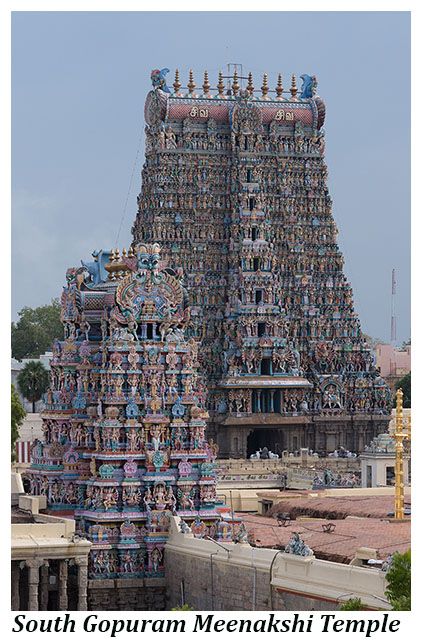
Saturday October 19th. 2013
People: Claudine Van Massenhove (photographer) Johnny Fincioen (author) Baskar (guide) Ramalingam (driver).
We find our way through a narrow alley to the large quadrangle on which the giant temple complex is built. A rather broad walkway, bordering the temple wall, circles the temple on all four sides. Gray and wine-red tiles fill in the surface of the promenade. Motorized traffic is not allowed on the pavement during the busiest hours of the day.
Historians believe that the beginnings of the Meenakshi Amman Temple date back to around 500 BCE. The poet Thirugnanasambandar praised it in one of his 7th century CE poems. The Pandiyan King, who built the temple, taxed all inhabitants of the city to help establish and finance the construction. Wealthy residents had to pay gold and silver. Poor people had to give a certain amount of rice every day to feed the construction crew. I applaud this taxing system. Everybody should have skin in the game. Everybody should have a financial interest in the way taxes are spent. That’s why a flat tax whereby everybody, from poor to rich, pays an equal percentage is the fairest tax system. Here, the king’s system created an emotional attachment of all Madurai inhabitants to the temple.
No surprise, the temple was sacked by the Muslim invaders in 1310, and everything of value was stolen and everything of beauty destroyed. Raised to the ground, as they say, except for the Eastern Gopuram, which survived somehow relatively intact. In 1559, the first Nayak decided to rebuild the temple. About hundred years later, between 1623 and 1655, the temple was considerably expanded.
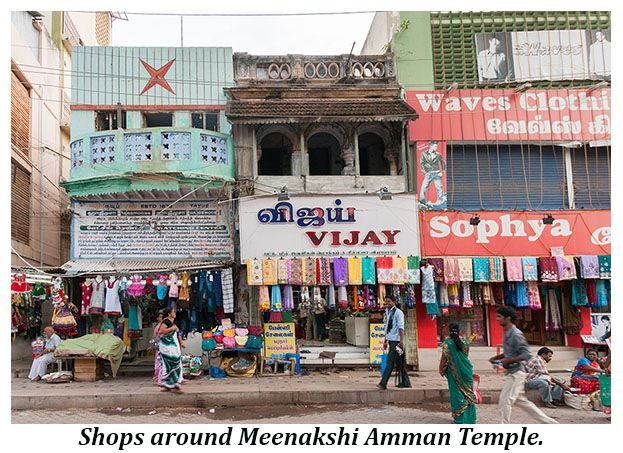
On the opposite side of the temple, this walkway has been turned into a continuous wall of shops and businesses. Most houses are two or three stories high.
Baskar reads Claudine’s mind and leads us to the three level high Art Bazar, called the Collage Arts Emporium. A guard with a rifle in his hands is posted in front of the shop. We enter the showroom, and Baskar gets permission for us to climb to the roof. Here, Claudine hopes to be able to get some photos of the temple complex and its fourteen towers, its Gopurams. The height of the tallest towers varies between forty-five and fifty meters, the tallest one, being the South Gopuram is just short of fifty-two meters. The towers inside the complex are shorter.
Of course, the merchant and its many sales people try to sell us some of their beautiful merchandise such as sculptures, large and small, in stone or brass, religious and other antiques, Kashmir carpets, paintings small and large, colorful and exquisite textiles, rare musical instruments, and so much more. We respectfully decline, but for sure, if we would have been in a buying mood, we recommend this store. They offer beautiful and exclusive merchandise.
We climb three flights of narrow staircases, avoiding baskets and boxes, and arrive on the flat roof. We have a clear view over the city at the back of the shop. But in the front?
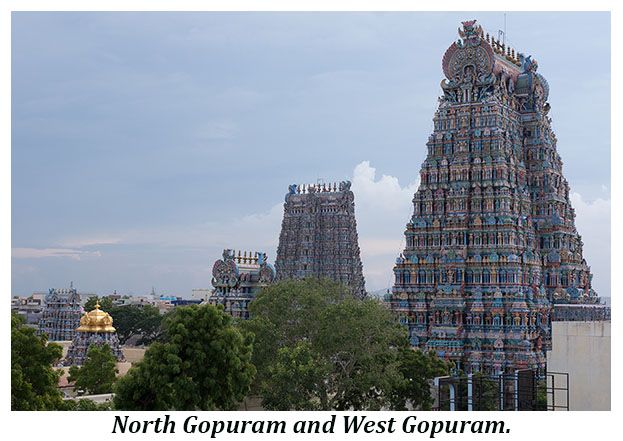
Ideally, our viewpoint should have been a couple of stories higher. We are at level with the top of the temple wall. Still, we have a shot at the many entrance Gopurams, four of them, one on each side, and other shorter towers dispersed in the center of the temple complex. We notice a couple of small, golden domes, as well. Each sits on top of one of the two most famous shrines, the one for Lord Shiva and the one for Devi Meenakshi. The bright, shiny, classic, golden flagstaff pierces through one of the roofs. This pole is composed out of thirty-two sections just as the human spine is. The entire surface of the big square temple complex seems to be filled with stone structures. The limited number of trees, adding some dark green to the abundance of colors, have been banned to the sides. Flat, pale, red roofs, intersected by small open squares, create the idea of a platform in between the towers.
DSC09753
After the photo shoot, we descend the stairs and decide to walk around the large temple. This stroll will allow us to admire details of the Gopurams and experience the atmosphere hanging around the temple. We start at the north side and walk counter clockwise. The first thing we notice is that the temple is closed for the moment, but the priests will open it soon for the evening prayers.
In Chapter seven, Baskar told us a legend about the wedding between Meenakshi and Lord Shiva, here known as Sundareswarar. It was about how the river got its name, remember? He told us about Lord Shiva’s wedding here in Madurai, too. But, in the previous chapter, he revealed us the “official” version of said marriage.
Indeed, the locals here in Madurai believe that this celestial wedding happened at this temple, not in the Himalayans as “official” Hinduism claims. Every evening during a ceremony and a procession, the idol of Lord Shiva, carried on a palanquin, is brought to Meenakshi, Parvati. The god is placed in her bed, set in a chamber made of pure silver. Of course, in the morning, both personalities are separated again during another ceremony.
“What is the lesson of this story?” I dare Baskar.
He smiles, “That it is good for the husband to sleep with his wife, and that it is right for the wife to welcome her husband in her bed.”
I second that.
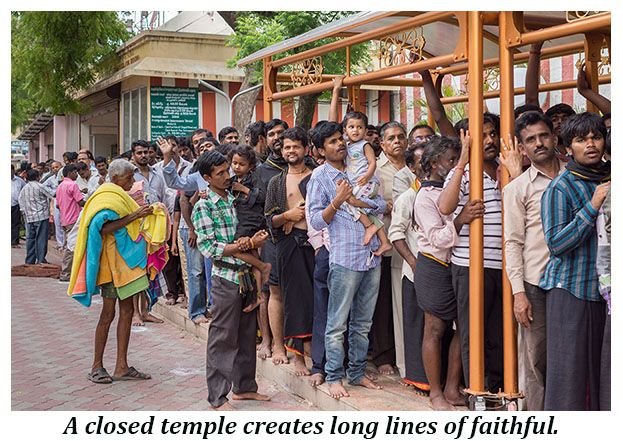
The temple receives about 20,000 visitors per day, give or take 5,000. Hundreds of people are amassed in front of each of the many entrance gates. They stand, separated by gender, glued against each other since Indians have a different notion of private space. It will be a zoo inside the temple when this mass of human bodies struggle to be the first in front of one of the idols. We have witnessed it before, and we do not want to be part of the stampede. Besides, why to wait in line for maybe another half an hour when there is so much to see from the street.
The first tower we try to admire in more detail is the North Gopuram. Since we can only stand back as far as the shops, about ten, maybe fifteen meters, we have to stretch our necks and look up almost vertically to see the top of the tower. An abundance of reds, greens, blues and yellows create such a mixture of colors, it is hard at first to identify individual details. The vividness of the colors on this tower and the other towers of the temple here is striking and different from the paler pastel colors on most other Temple Gopurams.
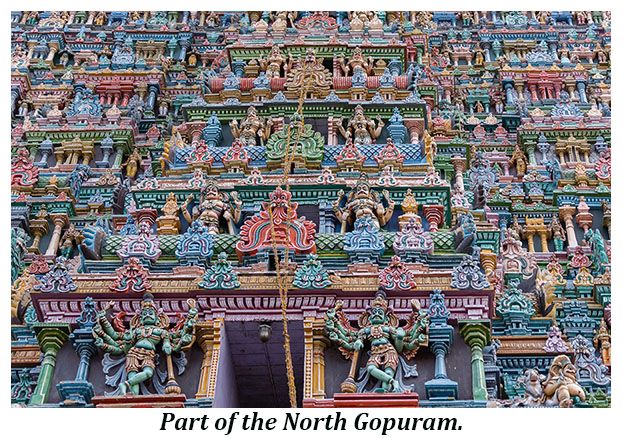
Above the thick and tall, non-painted entrance block stands the pyramidical tower with all its statues and its trunk-cake-like, pink top. The pyramid is organized in layers. The lowest layer shows a large opening in the middle, flanked by two four-armed, mustached and fierce-looking door-keepers, called Dwarapalakas. One of their feet rests on top of a cobra’s head. The next layer of statues also features an opening in the middle, here with two eight-armed, green Dwarapalakas. Every level has such opening, such “door,” and is flanked by statues of guardians.
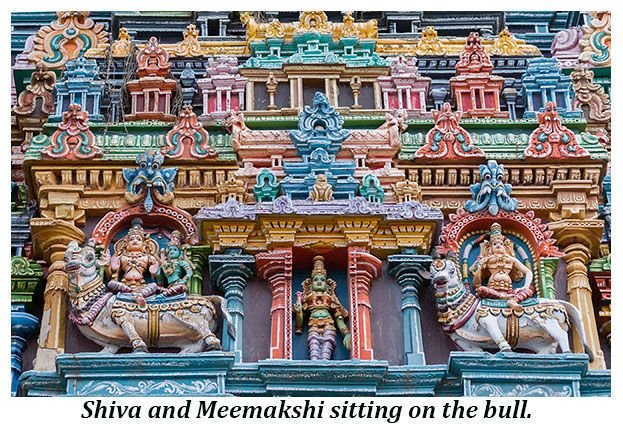
The extensive use of images of pillars in all shapes, colors and sizes set this entrance Gopuram apart from other temples. Some pillar combinations are just that, but in other instances, a small statue might (almost) hide in between the pillars. But they are all hard to identify from the street level. At the lowest levels, we recognize, though, a beige Lord Shiva and his rat-poison-green Meenakshi sitting on a bull, and another statue where a beige Parvati sits alone on a white, highly decorated Nandi, the bull.
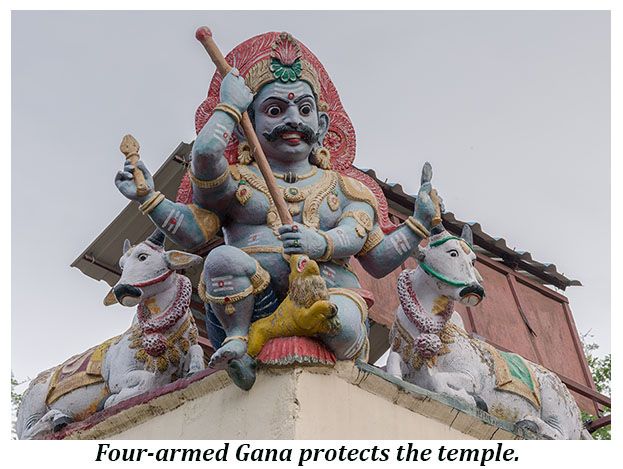
The tall temple wall, circling the temple grounds is decorated with a few simple, naive-looking, painted murals. One is Devi Lakshmi showered by two white elephants. Another is again the goddess Lakshmi sitting on a red lotus with the two white elephants trumpeting her praise. At regular intervals, a small statue of the white Nandi, the bull, graces the top of the temple wall as proof that Lord Shiva resides in the temple. On the corners, we identify four-armed Ganas, a kind of celestial servants and guardians of the gods. This wall imagery has lost most of its splendor since very often the colors have chipped off or have been smeared with plaster and cement.
Most of the pilgrims in the streets wear regular street clothing as they do every day. However, here and there, we stumble upon men who walk barefoot with just a dhoti around their waists and paint white stripes over their foreheads and other body parts.
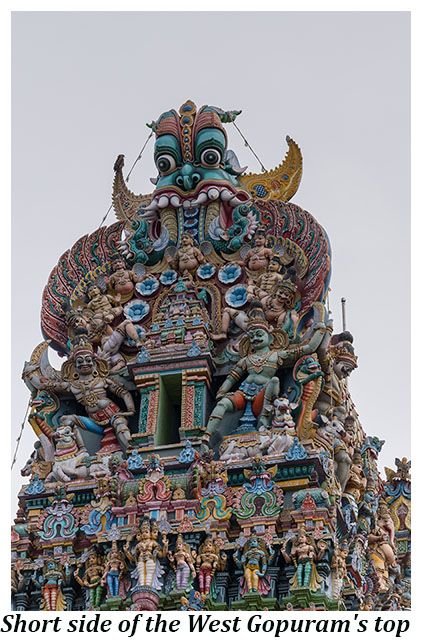
We have a better view on the Western Gopuram since we can stand from it at a larger distance. For sure, more statues have been added to this tower. Especially the short side of the top is stunning in its colors and multitude of images.
Lord Shiva is presented in some his avatars, as an actor in several of the legends about him, such as him covered in the hide of an elephant. Lord Shiva’s sons, Ganesha, and Murugan have found several spots on the tower, too. But Lord Vishnu and many other gods and goddesses are present, as well. No discrimination of Hindu gods here.
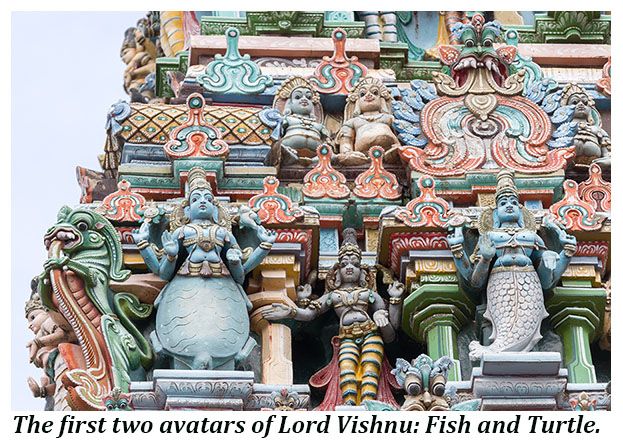
The first avatar of Lord Vishnu, a fish, and the second avatar of him, like a turtle, appear side by side. Of course, the famous image of him in his Narasimha appearance with the lion head shows up in several spots. The famous cruel picture of him cutting open the belly of the demon Hiranyakasipu with his hands can’t be missed.
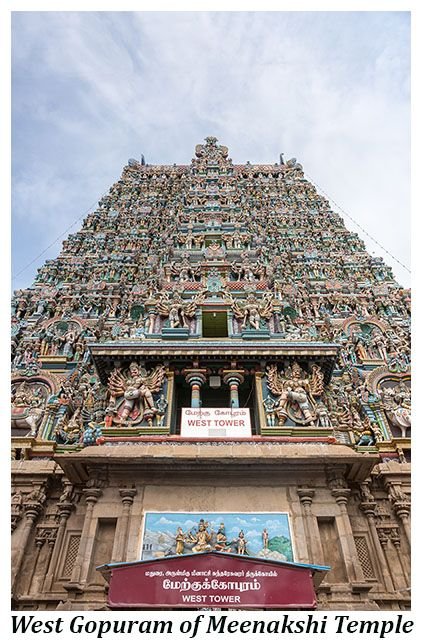
Especially attractive is the half-painting, half-sculpture composition right above the entrance gate-opening of the power. It shows Lord Shiva’s family, his wife and two sons, each with their mounts. Lord Ganesha with his rat, and Lord Murugan with his peacock. The background looks like the Himalayan mountains where he lives on Mount Kailash.
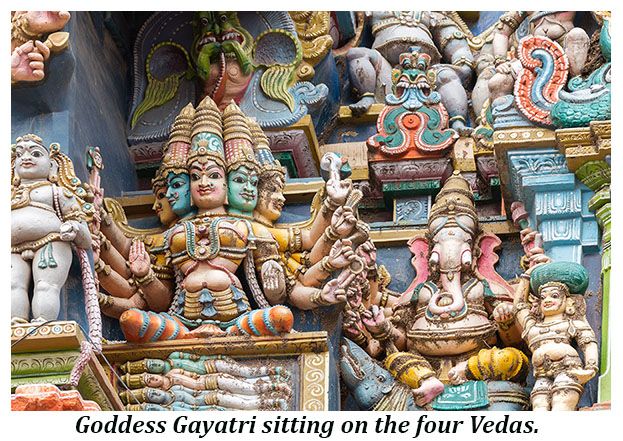
Baskar has to help me identify a five-headed woman with ten arms and sitting on what looks like a coffin wherein four human bodies are stretched on top of each other
“It is the goddess Gayatri. She personifies the four Vedas, which are depicted under her. In her hands, she holds the weapons of the three Lords, Shiva, Vishnu, and Brahma.
Of course, the Vedas are the ancient texts brought into India by the Indo-European conquerors six millennia ago. The Vedas constitute the fundaments of Hinduism.
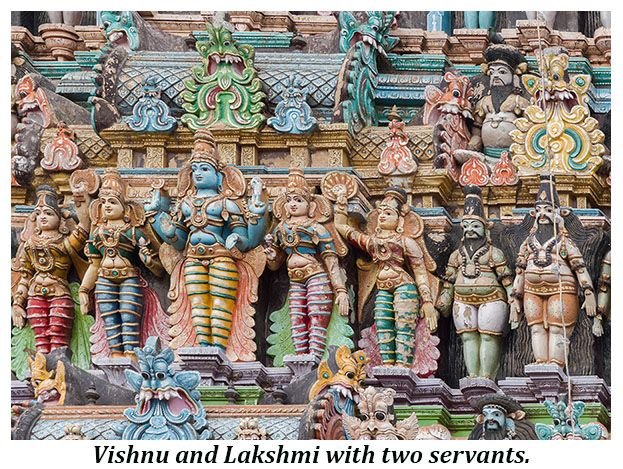
The number of Vishnu statues on the different towers surprises me somewhat. Isn’t this a Shiva temple? For example, the South tower features Vishnu with two women on both sides.
“Does Vishnu have four wives, Baskar?”
“No, look closer, the two women on the extremes are servants. Don’t you see they are holding fans above the divine trio?”
“Now I see it. I like the style of their pants, though,” I say, changing the subject. Now, Baskar looks closer and laughs.
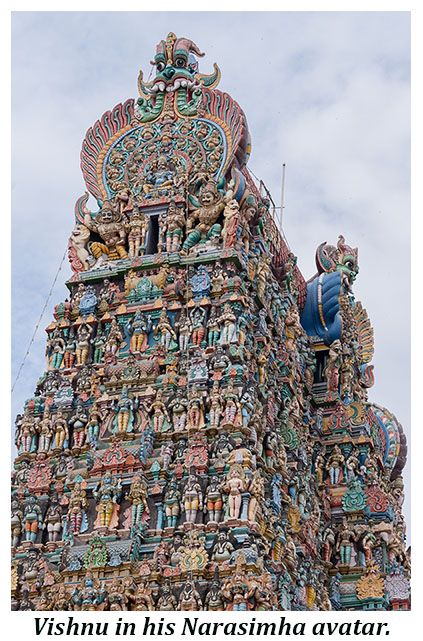
I have a similar problem with the short side of that South Gopuram. I recognize Vishnu as Narasimha, with the lion head, but again, he is surrounded by a collection of women: his two wives on his side, and then a circle of others holding their hands together.
“Servants, too?”
“Indeed.”
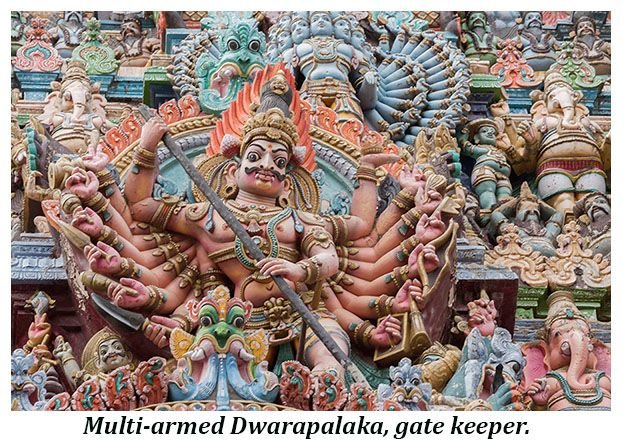
One Dwarapalaka, a gate-keeper, on this South Tower is an army on his own. He has sixteen arms holding a different weapon in each of his hands! He sports a feather-like—or are these flames?—hear ornament. Not to be undone by a simple Dwarapalaka, Lord Shiva appears just above him with twenty-five heads and fifty arms. This representation is Lord Shiva in his “Maha Sadashiva Murthy” avatar. It will not be Hinduism if each of the heads has not a specific name and meaning.
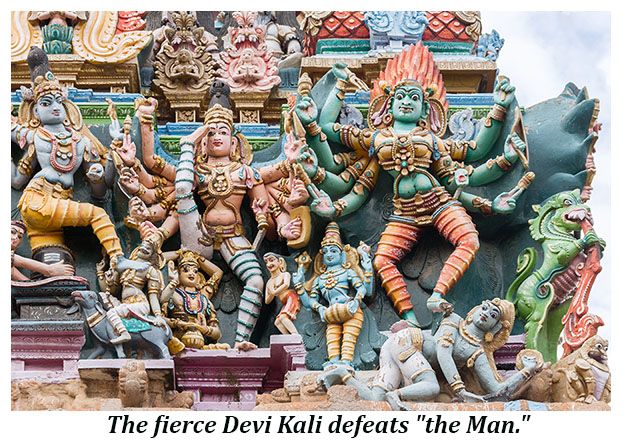
The famous Devi Kali can’t be absent, of course. One great statue shows her defeating “The Man.” She appears several times on the South Tower carrying weapons in each of her eight hands. Kali is the aggressive representation of Devi Durga.
Durga is an avatar of Parvati, wife of Shiva. Brahma, one of the triumvirate of upper-gods in Hinduism, had unleashed a monster, Mahusgasura, onto the earth. Only a woman could defeat that beast. A thoughtful touch of Brahma, I say. So, Shiva asked his wife Parvati to take on the monster. The three gods, Brahma, Shiva, and Vishnu, shone an intense light on her and thus created her avatar, Durga, who went on to defeat the monster. The defeat is a long story in itself. The monster has several lives and attacks her for example as a buffalo, an elephant, a lion and finally, a man—surprise! But, of course, she wins in the end. In attack mode, Durga is presented as Kali, a bloodthirsty female. It is not unusual to see her with blood dripping out of her mouth and with a chain of human skulls around her waist or around her neck. Thus, the Kali here is pretty decent.
Before moving on, I should mention the painting-sculpture composition above the entrance of the South Tower. It shows Lord Shiva as the supreme teacher surrounded by gurus, a very common icon reproduced thousands of times inside and outside Hindu temples.
It would take hours to identify and admire each of the many statues on the different towers. The power and uniqueness of such Gopurams are the combination of colors and the abundance of sculptures, each with a legend linked to them. When the West and the South tower seem to feature more images, the North, and East towers are similar in the use of the pillar theme throughout the flanks of the tower.
The temple grounds incorporate a large tank, a pond of about 50x37 meters. Baskar claims that the water of the reservoir could (in the past) judge the literary value of poems. The temple authorities put the written text on top of the water. A poorly written poem would sink in the tank, but an excellent text would float. Other exciting attractions of the temple, apart from the idols, are over 30,000 statues and murals, a large birdcage with green parrots, that are trained to repeat “Meenakshi”—if you listen well—and overly decorated Mandapams with beautiful ceilings and chiseled pillars.
At the eastern entrance tower, our attention is drawn to a beautiful niche. In it, two statues stand opposite to each other. The background is a painting of what seems to be a scene of war, a scene of conquest, where some people flee or get killed by others. The green idol on the left is Meenakshi. She bows her head (only) slightly towards the four-armed, beige figure, Lord Shiva. Both persons hold a Royal staff, looking a bit like a long bow, in their hands. She stands on what looks like an old, wheeled, golden wagon used in coal mines. He stands on boulders that one may confuse with cannon balls. (Picture is featured in previous chapter.)
In chapter two, the origins of the Tamils, we touched on the conviction of the Tamils, that they created the first civilization of the world and went on to spread civilization to all corners of the world.
Interestingly, Baskar repeats this confidence when he presents the meaning of the scenery in the niche, a legend we touched on this morning.
“The green person is Meenakshi, and the other one is Lord Shiva. You know, that Meenakshi, once she became queen, went on to successfully conquer the entire world. Except, when she wanted to capture the last remaining free parcel, the Himalayans, she was confronted by Lord Shiva as the opposing general. On seeing Lord Shiva, she fell in love—her third breast disappeared—and they united their territories by marrying each other.”
The wedding of Meenakshi and Lord Shiva are the central piece of iconography in Madurai. As seen before, generally, the people of Madurai place that wedding here in Madurai. But, this niche seems to suggest that the “official” Hindu legend, putting the wedding in the Himalayans instead, is also recognized at the temple.
Baskar disagrees, “There are no Himalayans in this image!”
I give him the last word, after all, he is a proud citizen of Madurai.
84 high resolution pictures of the temple:
http://galleries.fin-mas.com/p529005343
Congratulations @claudinevm! You have completed some achievement on Steemit and have been rewarded with new badge(s) :
Click on any badge to view your own Board of Honor on SteemitBoard.
For more information about SteemitBoard, click here
If you no longer want to receive notifications, reply to this comment with the word
STOPCongratulations @claudinevm, you have decided to take the next big step with your first post! The Steem Network Team wishes you a great time among this awesome community.
The proven road to boost your personal success in this amazing Steem Network
Do you already know that awesome content will get great profits by following these simple steps, that have been worked out by experts?